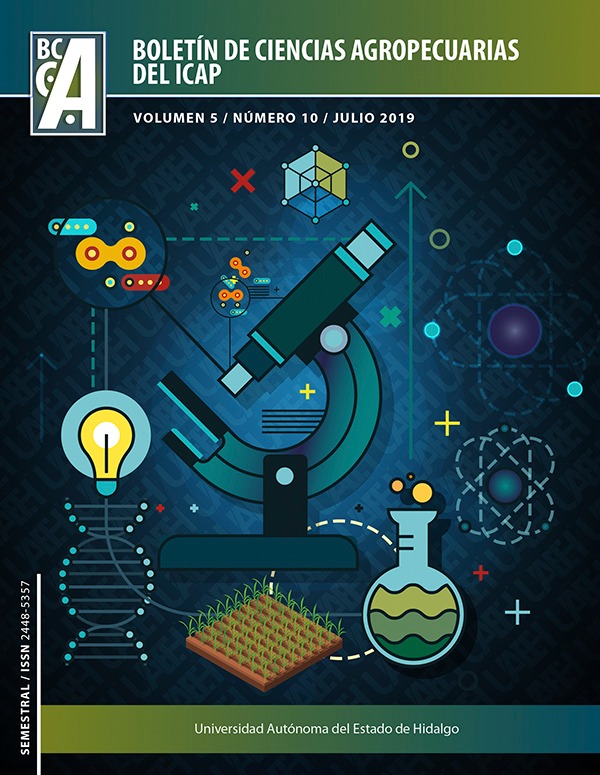Insects as an Alternative Food and Cancer Option
Abstract
The consumption of insects around the world is increasingly accepted in different cultures, because they are easy to grow, reproduce simply and do not require much maintenance, so they are being proposed as an alternative and viable source of nutrients, not only for pet consumption but also for human consumption, in addition to this great nutritional benefit insects are used as alternative treatments in traditional medicine, to cure or prevent some diseases, including cancer
Downloads
References
Belluco, S., Losasso, C., Maggioletti, M., Alonzi, C. C., Paoletti, M. G., & Ricci, A. (2013). Edible insects in a food safety and nutritional perspective: a critical review. Comprehensive Reviews in Food Science and Food Safety, 12(3), 296-313.
Cahuich-Campos, D., & Granados, F. F. (2014). Entomoterapia: curaciones entre los antiguos pueblos mayas de la península de Yucatán, México. ELOHI. Peuples indigènes et environnement, (5-6), 39-54.
Deloya-Brito, G. G., & Deloya, C. (2014). Sustancias producidas por el coleóptero Ulomoides dermestoides (Chevrolat, 1878) (Insecta: Coleoptera: Tenebrionidae): efecto anti-inflamatorio y citotóxico. Acta zoológica mexicana, 30(3), 655-661.
Dreassi, E., Cito, A., Zanfini, A., Materozzi, L., Botta, M., & Francardi, V. (2017). Dietary fatty acids influence the growth and fatty acid composition of the yellow mealworm Tenebrio molitor (Coleoptera: Tenebrionidae). Lipids, 52(3), 285-294.
Elorduy, J. R., Pino, J. M., & Correa, S. C. (1998). Insectos comestibles del Estado de México y determinación de su valor nutritivo. Anales del Instituto de Biología. Serie Zoología, 69(1), 65-104.
Gajski, G., & Garaj-Vrhovac, V. (2013). Melittin: a lytic peptide with anticancer properties. Environmental toxicology and pharmacology, 36(2), 697-705.
Liu, Y. F., Ma, R. L., Wang, S. L., Duan, Z. Y., Zhang, J. H., Wu, L. J., & Wu, C. F. (2003). Expression of an antitumor–analgesic peptide from the venom of Chinese scorpion Buthus martensii karsch in Escherichia coli. Protein expression and purification, 27(2), 253-258.
Lizhang, W., Montesinos, J. L., & Dinghong, Y. (2008). Los insectos como fuente de alimento: Análisis del contenido en proteína y grasa de 100 especies. Bol. Mus. Mun. Funchal, Sup., 14, 55-70.
Moore, A. J., Devine, D. A., & Bibby, M. C. (1994). Preliminary experimental anticancer activity of cecropins. Peptide research, 7(5), 265-269.
Ramos-Elorduy, J., & Viejo-Montesino, J. (2007). Los insectos como alimento humano: Breve ensayo sobre la entomofagia, con especial referencia a México. Boletín Real Sociedad Española de Historia Natural. Sección Biología, 102(1-4), 61-84.
Ravzanaadii, N., Kim, S. H., Choi, W. H., Hong, S. J., & Kim, N. J. (2012). Nutritional value of mealworm, Tenebrio molitor as food source. International Journal of Industrial Entomology, 25(1), 93-98.
Rumpold, B. A., & Schlüter, O. K. (2013). Potential and challenges of insects as an innovative source for food and feed production. Innovative Food Science & Emerging Technologies, 17, 1-11.
Siemanowska, E., Kosewska, A., Aljewicz, M., Skibniewska, K. A., Polak-Juszczak, L., Jarocki, A., & Jedras, M. (2013). Larvae of mealworm (Tenebrio molitor L.) as European novel food. Agricultural Sciences, 4(6), 287-291.
Smetana, S., Larki, N. A., Pernutz, C., Franke, K., Bindrich, U., Toepfl, S., & Heinz, V. (2017). Structure design of insect-based meat analogs with high-moisture extrusion. Journal of Food Engineering. doi: 10.1016/j.jfoodeng.2017.06.035
Wang, C. C., Wu, C. H., Hsieh, K. J., Yen, K. Y., & Yang, L. L. (2000). Cytotoxic effects of cantharidin on the growth of normal and carcinoma cells. Toxicology, 147(2), 77-87.
Yi, L., Lakemond, C. M., Sagis, L. M., Eisner-Schadler, V., van Huis, A., & van Boekel, M. A. (2013). Extraction and characterisation of protein fractions from five insect species. Food chemistry, 141(4), 3341-3348.
Yoo, Y. C., Shin, B. H., Hong, J. H., Lee, J., Chee, H. Y., Song, K. S., & Lee, K. B. (2007). Isolation of fatty acids with anticancer activity from Protaetia brevitarsis larva. Archives of pharmacal research, 30(3), 361-365.










